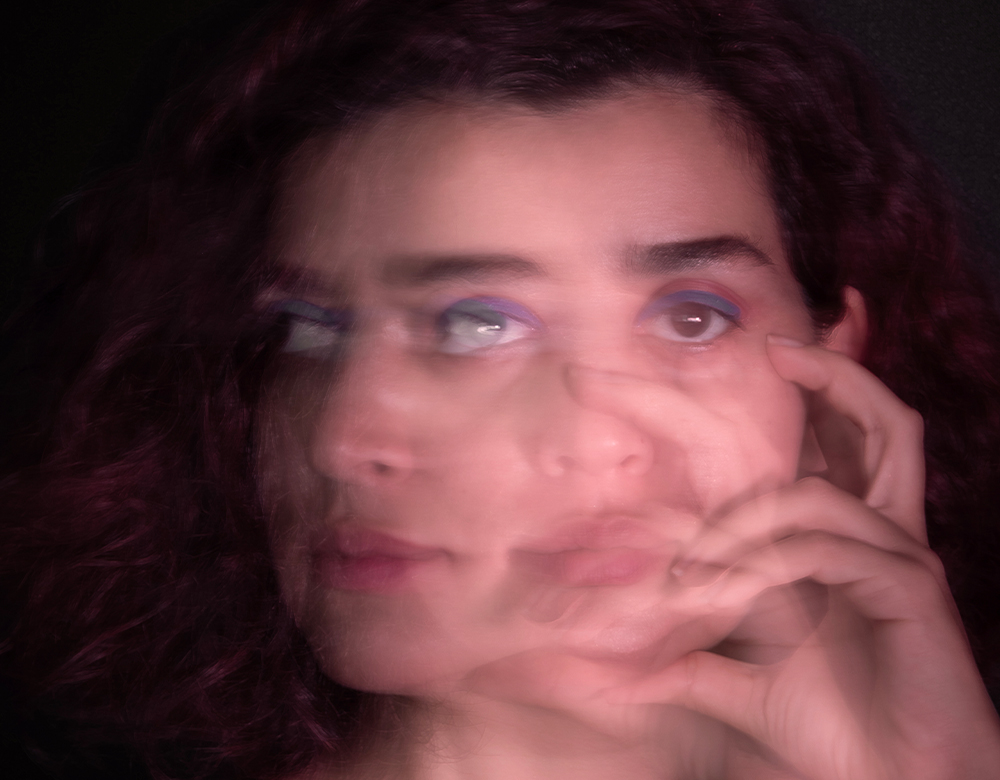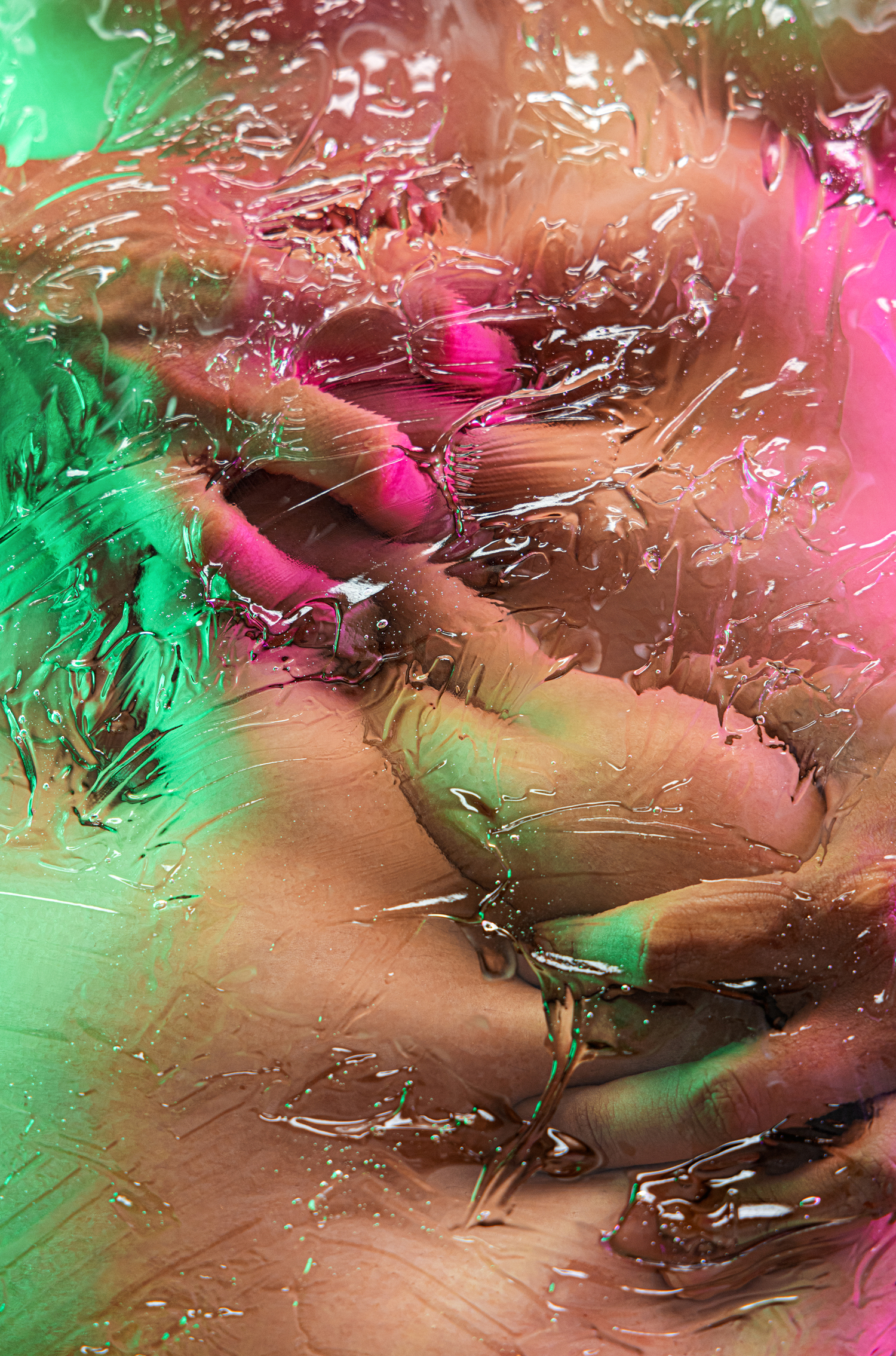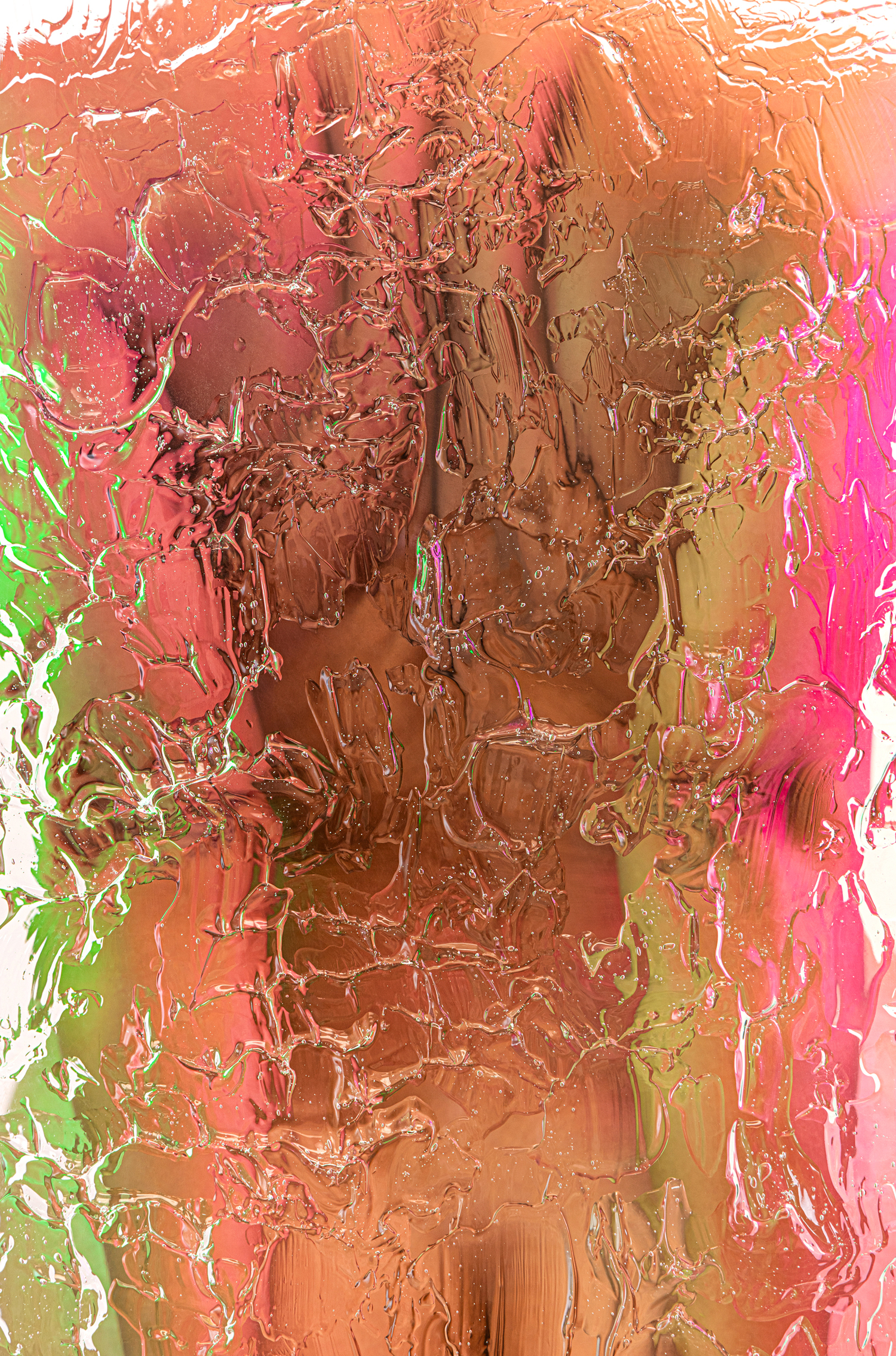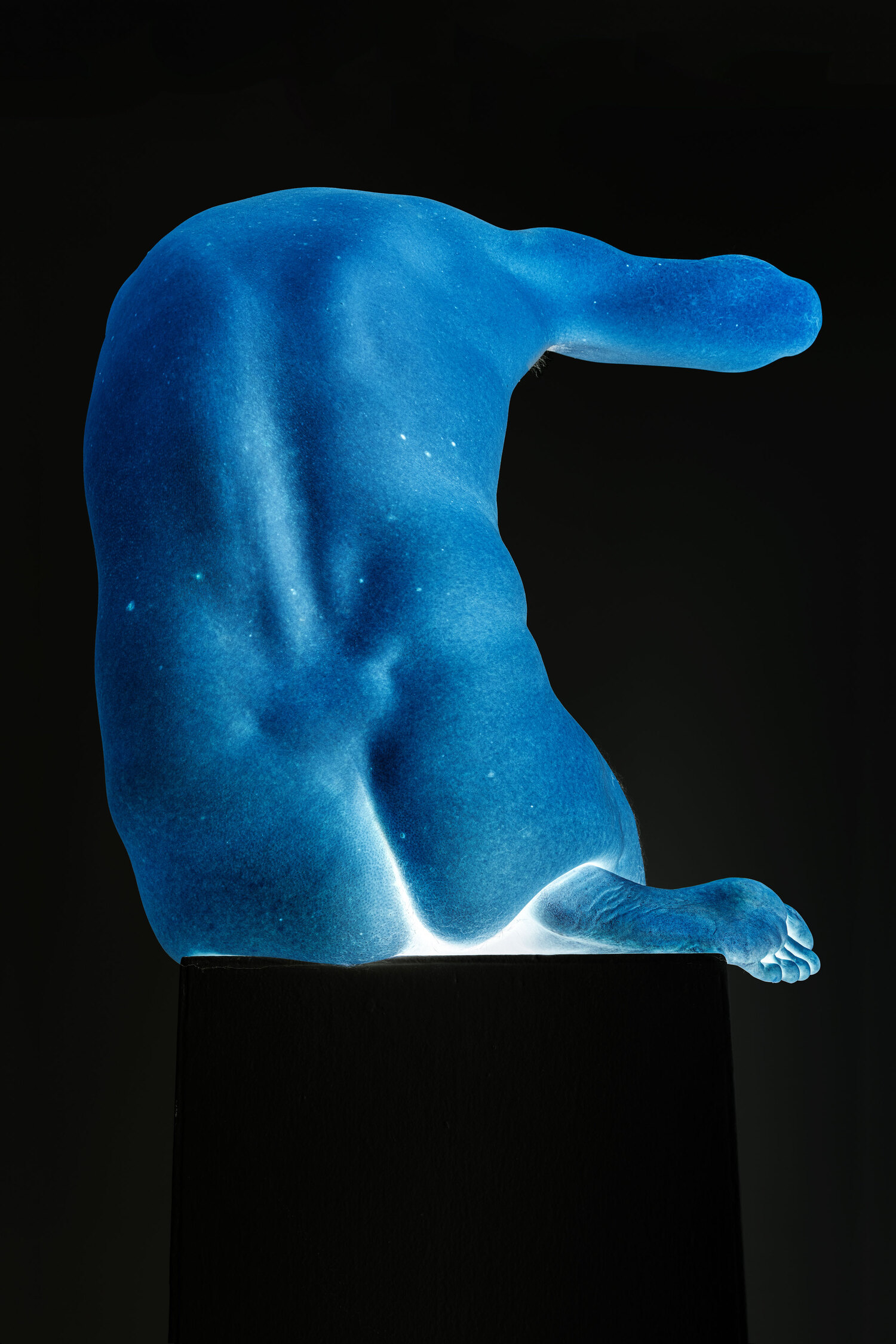Azarakhsh Shafieikadkani
Year of birth: 1987
Location: Boca Raton, Florida
Education: Master of Fine Arts in Studio Art with a concentration in Photography (Florida Atlantic University), and a Master’s degree in Graphic Design.
Describe your art in three words: Gaze, Identity, Deconstruction.
Website

Your work focuses on the concept of the fragmented gaze, drawing from Laura Mulvey’s theories. Could you elaborate on how you interpret and utilize this idea in your photographs?
Laura Mulvey’s theory of the fragmented gaze, introduced in her groundbreaking essay Visual Pleasure and Narrative Cinema, explores how visual culture, particularly cinema fragmentizes and objectifies female bodies. She argues that women are often reduced to isolated, eroticized parts (such as lips, legs, or curves), emphasizing their status as objects for male pleasure rather than whole, autonomous beings. This fragmentation not only diminishes agency but also perpetuates a patriarchal dynamic in which the male gaze dominates the visual narrative.
In my photographic work, I reinterpret and subvert Mulvey’s concept of fragmentation. Rather than using fragmentation to objectify, I employ it as a means of resistance. For instance, in this project, I used matte Mylar paper to obscure my models’ faces and bodies, creating an intentional sense of ambiguity and incompletion. By cutting away parts of the Mylar, specific portions of the body are revealed, but these exposed areas are carefully curated to resist conventional notions of eroticism or objectification.
This fragmented presentation forces the viewer to grapple with an incomplete, disrupted image. The blurred and unclear forms challenge the traditional expectation of coherence and clarity, shifting the dynamic of the gaze. Instead of being passively consumed, the bodies in my work demand a more nuanced, critical engagement. This strategy invites viewers to question their own gaze and the societal constructs that shape how we perceive and objectify bodies. Through this process, fragmentation becomes a tool for empowerment and liberation, transforming the gaze from one of dominance to one of introspection and resistance.
How do you feel your experimental photography techniques, like using LED lighting and Mylar matte paper, influence the viewer’s perception of the human form?
My experimental photography techniques, particularly the use of Mylar matte paper and LED lighting, play a central role in reshaping the viewer’s perception of the human form. The Mylar matte paper obscures and fragments the body, creating a blurred, ambiguous surface that challenges the viewer’s ability to fully “consume” the subject. By selectively cutting parts of the Mylar to reveal portions of the body, I introduce an intentional fragmentation that resists objectification and focuses attention on the interplay between what is concealed and what is exposed.
LED lighting complements this approach by creating dynamic contrasts, illuminating textures, and emphasizing the distortions caused by the Mylar. The interplay of light and shadow abstracts the form, drawing attention away from traditional markers of identity and toward a more fluid and interpretive understanding of the body. Together, these techniques disrupt the viewer’s expectations of clarity and coherence, inviting them to engage with the body as a site of complexity and transformation, rather than a static or consumable object.
 Azarakhsh Shafieikadkani | Deconstruction | 2024
Azarakhsh Shafieikadkani | Deconstruction | 2024In your artist statement, you mention reclaiming fragmented forms as tools for liberation. How do you see this process unfolding in both the creation and reception of your work?
Reclaiming fragmented forms as tools for liberation unfolds in my work through both the creative process and its impact on viewers. In creation, fragmentation becomes a deliberate method of challenging traditional representations and resisting objectification. In my experimental photography, I intentionally break apart the human form. This deconstruction reclaims control over how bodies are represented, emphasizing fluidity and ambiguity rather than fixed identities or societal expectations.
In reception, these fragmented forms invite viewers to engage more critically with the images. The lack of clarity forces them to confront the discomfort of incomplete or distorted figures, challenging their assumptions and typical ways of seeing. This disruption shifts the focus from passive consumption to active questioning, opening space for new interpretations of the body as dynamic, multifaceted, and resistant to objectification. Ultimately, this process becomes a liberatory act—both for me as the creator and for viewers by dismantling male gaze and encouraging a more nuanced and expansive way of seeing.
Can you describe the significance of color and light in your compositions and how they contribute to the overall concept of your work?
Color and light play a pivotal role in my compositions, serving as both aesthetic elements and conceptual tools that enhance the themes of my work. They contribute to the emotional tone, the perception of the body, and the overall narrative I aim to convey.
Light acts as a medium for transformation and fragmentation. By using techniques like LED lighting, reflective surfaces, or backlighting, I create dramatic contrasts and distortions that alter the way the body is perceived. This manipulation of light fragments the form, blending it into its environment or reshaping it into abstract, otherworldly figures. Light becomes a metaphor for revelation and concealment, emphasizing the fluidity of identity and the complexity of how we are seen or unseen.
Color introduces emotional depth and symbolic resonance. I draw inspiration from Cindy Sherman’s photographs, particularly her use of different color themes to evoke diverse personas and emotional states. Similarly, I use color to amplify the narrative in my work muted, earthy tones in my nature-based series emphasize a harmonious connection between the body and the natural world, while vibrant or surreal hues in my studio work enhance the sense of disconnection and ambiguity in fragmented forms.
Together, color and light become vital to the storytelling in my work. They do more than illuminate or decorate they shape the viewer’s experience, reinforce the fragmentation and abstraction of the human form, and invite deeper contemplation of themes like identity, gaze, and liberation. Through these elements, I aim to create compositions that are emotionally charged and visually compelling.
Light acts as a medium for transformation and fragmentation. By using techniques like LED lighting, reflective surfaces, or backlighting, I create dramatic contrasts and distortions that alter the way the body is perceived. This manipulation of light fragments the form, blending it into its environment or reshaping it into abstract, otherworldly figures. Light becomes a metaphor for revelation and concealment, emphasizing the fluidity of identity and the complexity of how we are seen or unseen.
Color introduces emotional depth and symbolic resonance. I draw inspiration from Cindy Sherman’s photographs, particularly her use of different color themes to evoke diverse personas and emotional states. Similarly, I use color to amplify the narrative in my work muted, earthy tones in my nature-based series emphasize a harmonious connection between the body and the natural world, while vibrant or surreal hues in my studio work enhance the sense of disconnection and ambiguity in fragmented forms.
Together, color and light become vital to the storytelling in my work. They do more than illuminate or decorate they shape the viewer’s experience, reinforce the fragmentation and abstraction of the human form, and invite deeper contemplation of themes like identity, gaze, and liberation. Through these elements, I aim to create compositions that are emotionally charged and visually compelling.
 Azarakhsh Shafieikadkani | Deconstruction | 2024
Azarakhsh Shafieikadkani | Deconstruction | 2024What role do you believe the viewer plays in interpreting the fragmented bodies you create? How do you encourage them to engage with your work beyond its surface aesthetic?
The viewer plays a central role in interpreting the fragmented bodies in my work. The distortion and abstraction I employ invite them to engage beyond surface-level aesthetics and consider deeper questions of identity, perception, and power dynamics.
The fragmented nature of the bodies challenges the viewer’s expectation for clarity. As they navigate through the ambiguity, their own gaze becomes a key element in the work’s meaning. The selective visibility of body parts creates a disorienting experience, where the familiar is made strange. This partial visibility encourages viewers to confront their own interpretation, wrestling with the tension between what is shown and what is hidden.
Rather than simply passively observing, the viewer is called to engage actively with the work, to fill in the gaps, and question what remains concealed. In doing so, they are prompted to reflect on how their gaze is shaped by societal norms, expectations, and constructs around identity. The fragmented bodies resist the viewer’s desire for coherence, highlighting the discomfort and power inherent in looking, forcing them to confront their role in interpreting the body.
Through this engagement, I aim to shift the gaze from a passive, objectifying act to one of self-awareness and critical reflection. The fragmented bodies become a mirror, not just of identity, but also of the viewer’s relationship to the gaze itself, revealing how deeply personal and political the act of looking can be.
Through this engagement, I aim to shift the gaze from a passive, objectifying act to one of self-awareness and critical reflection. The fragmented bodies become a mirror, not just of identity, but also of the viewer’s relationship to the gaze itself, revealing how deeply personal and political the act of looking can be.
How does your background in feminist and psychoanalytic theories influence your artistic practice and how you approach the representation of bodies?
My background in feminist and psychoanalytic theories deeply influences my artistic practice, particularly in how I approach the representation of the human body. Central to my work is the idea that the body is not just a passive object, but an active site for exploring identity, power, and perception. Feminist theory, particularly the works of Laura Mulvey and bell hooks, informs my critical approach to the ways bodies, especially those of marginalized individuals have been objectified and fragmented under patriarchal and societal structures. Psychoanalytic theory, with its focus on unconscious desires and projections, deepens my exploration of how bodies are perceived, desired, and distorted.
I focus on the human body as a medium for expressing the complexities of identity, power dynamics, and personal and collective trauma. By representing bodies in abstracted and fragmented ways, I aim to challenge traditional portrayals that reduce the body to mere objecthood. This fragmentation, whether through my experimental studio techniques or abstract compositions, pushes back against how patriarchal systems have historically reduced bodies—especially women’s and marginalized genders’ bodies to parts for consumption or idealization. The fragmented body becomes a way to subvert and reclaim space, identity, and autonomy, offering a nuanced perspective that resists simplistic visual readings.
The materials and techniques I use are deeply tied to these theoretical concerns. For example, the use of Mylar, with its ability to blur and distort the human form, serves as a metaphor for how societal expectations and constructs obscure and fragment identity. The selective visibility it creates forces the viewer to confront partiality and ambiguity, challenging the desire for clear, unified forms. Similarly, I use transparent plexiglass covered in hair gel, which sits between the camera and subject, to create a veil of distortion. This technique abstractly manipulates the body, highlighting how identity can be shaped and obscured by external and internal forces. Additionally, I invert bodies to negative isolated forms, a method that mirrors the psychological tension between visibility and invisibility, drawing attention to how marginalized bodies are often hidden or misrepresented in mainstream culture.
I focus on the human body as a medium for expressing the complexities of identity, power dynamics, and personal and collective trauma. By representing bodies in abstracted and fragmented ways, I aim to challenge traditional portrayals that reduce the body to mere objecthood. This fragmentation, whether through my experimental studio techniques or abstract compositions, pushes back against how patriarchal systems have historically reduced bodies—especially women’s and marginalized genders’ bodies to parts for consumption or idealization. The fragmented body becomes a way to subvert and reclaim space, identity, and autonomy, offering a nuanced perspective that resists simplistic visual readings.
The materials and techniques I use are deeply tied to these theoretical concerns. For example, the use of Mylar, with its ability to blur and distort the human form, serves as a metaphor for how societal expectations and constructs obscure and fragment identity. The selective visibility it creates forces the viewer to confront partiality and ambiguity, challenging the desire for clear, unified forms. Similarly, I use transparent plexiglass covered in hair gel, which sits between the camera and subject, to create a veil of distortion. This technique abstractly manipulates the body, highlighting how identity can be shaped and obscured by external and internal forces. Additionally, I invert bodies to negative isolated forms, a method that mirrors the psychological tension between visibility and invisibility, drawing attention to how marginalized bodies are often hidden or misrepresented in mainstream culture.
These materials and techniques, inspired by feminist and psychoanalytic thought, offer a way to deconstruct and reimagine the body outside of the limiting structures imposed by traditional representation. They encourage viewers to critically engage with the body not as a fixed entity, but as something fluid, fragmented, and multifaceted, challenging them to reconsider their own gaze and assumptions about identity. Through these methods, I aim to create a space for the human body to be seen as a site of liberation, complexity, and empowerment.
 Azarakhsh Shafieikadkani | The Power of Gaze | 2024
Azarakhsh Shafieikadkani | The Power of Gaze | 2024Your project challenges traditional representations of bodies, particularly those of women, nonbinary, and transgender individuals. How do you address the intersectionality of gender and representation in your work?
My project actively engages with the intersectionality of gender and representation by acknowledging and highlighting the diverse experiences and identities of women, nonbinary, and transgender individuals. This intersectional approach stems from an understanding that gender is not a singular or monolithic experience but rather one that is shaped by overlapping factors such as race, culture, sexuality, and societal expectations.
In my work, I strive to dismantle the rigid binaries and stereotypes that often dominate traditional representations of bodies. By using a combination of natural and experimental studio settings, I seek to create images that celebrate the fluidity and complexity of gender. For instance, in my nature-focused series, the human form is often integrated with organic landscapes, symbolizing the shared connection between the body and the natural world. This visual merging underscores the universality of bodily experience while still honoring the individuality and unique narratives of my subjects.
In the studio, I use abstraction and distortion techniques-such as photographing through textured surfaces like Mylar or manipulating body forms with glass and light-to deconstruct traditional visual cues of gender. By removing or obscuring features often used to categorize bodies, I invite viewers to move beyond preconceived notions and see the body as something dynamic and undefinable. This approach challenges the binary gaze and encourages a more inclusive perspective.
Additionally, the inclusion of nonbinary and transgender individuals in my work is an intentional effort to expand the scope of representation and provide visibility to those often marginalized in visual culture. I aim to create a space where their identities are not only acknowledged but also celebrated as integral parts of the broader conversation about gender and representation.
Ultimately, my work seeks to highlight the intersectionality of gender by offering images that resist simplification and invite viewers to consider the nuances of identity. Through these visual narratives, I hope to contribute to a broader dialogue about liberation, equity, and the importance of seeing beyond societal constructs.
In the studio, I use abstraction and distortion techniques-such as photographing through textured surfaces like Mylar or manipulating body forms with glass and light-to deconstruct traditional visual cues of gender. By removing or obscuring features often used to categorize bodies, I invite viewers to move beyond preconceived notions and see the body as something dynamic and undefinable. This approach challenges the binary gaze and encourages a more inclusive perspective.
Additionally, the inclusion of nonbinary and transgender individuals in my work is an intentional effort to expand the scope of representation and provide visibility to those often marginalized in visual culture. I aim to create a space where their identities are not only acknowledged but also celebrated as integral parts of the broader conversation about gender and representation.
Ultimately, my work seeks to highlight the intersectionality of gender by offering images that resist simplification and invite viewers to consider the nuances of identity. Through these visual narratives, I hope to contribute to a broader dialogue about liberation, equity, and the importance of seeing beyond societal constructs.

Leave a Reply